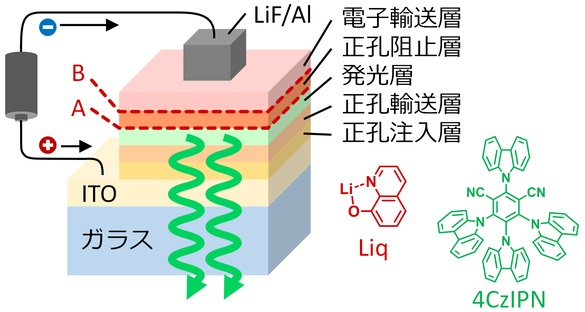Research Abstract
非常に薄いLiq中間層を用いた有機発光ダイオードの動作安定性の向上
Operational stability enhancement in organic light-emitting diodes with ultrathin Liq interlayers
2016年3月1日 Scientific Reports 6 : 22463 doi: 10.1038/srep22463

有機発光ダイオード(OLED)は、定電流動作時、駆動電圧上昇に伴い輝度が低下する。我々は、熱活性化遅延蛍光(TADF)を示す緑色発光体(4s,6s)-2,4,5,6-テトラ(9H-カルバゾル-9-イル)イソフタロニトリル(4CzIPN)を含有するOLEDにおいて、非常に薄い(1~3 nm)8-ヒドロキシキノリナートリチウム(Liq)中間層を正孔阻止層と発光層の間と正孔阻止層と電子輸送層の間に導入することによって安定性を大幅に向上させる方法を報告する。初期輝度1,000 cd/m2の定電流動作において、中間層を挿入すると、LT90(輝度が初期輝度の90%になるまでの時間)が8倍の1380時間になった。このLiq層挿入という新しいアイデアと混合ホスト系を組み合わせることで、さらにLT95が伸び、参照素子の16倍の1315時間になった。この値は、TADF系OLEDについて報告された中で最高であり、十分確立されたりん光系OLEDの動作寿命に匹敵する。熱刺激電流測定を行ったところ、非常に薄いLiq中間層を挿入すると深い電荷トラップの数が減少することがわかった。このことは、動作寿命の改善には深いトラップの数の減少が重要であること、また励起子-ポーラロン消滅が素子劣化の原因となっている可能性があることを示している。
Corresponding Authors
Organic light-emitting diodes (OLEDs) under constant current operation suffer from a decrease of luminance accompanied by an increase of driving voltage. We report a way to greatly improve the stability of OLEDs having a green emitter exhibiting thermally activated delayed fluorescence (TADF), (4s,6s)-2,4,5,6-tetra(9H-carbazol-9-yl) isophthalonitrile (4CzIPN), by introducing ultrathin (1 to 3 nm) interlayers of 8-hydroxyquinolinato lithium (Liq) between hole-blocking layer and its surrounding emissive and electron-transport layers. Under constant current operation starting at a luminescence of 1,000 cd/m2, the time to reach 90% of initial luminance (LT90) increased eight times, resulting in LT90 = 1,380 hours after insertion of the interlayers. Combining this new concept and mixed host system, LT95 was further extended to 1315 hours that is 16 times of reference device. This is the best value reported for TADF-based OLEDs and is comparable to the operational lifetimes of well-established phosphorescence-based OLEDs. Thermally stimulated current measurements showed that the number of deep charge traps was reduced with the insertion of the ultrathin Liq interlayer, indicating that reducing the number of deep traps is important for improving the operational lifetime and that exciton-polaron annihilation may be a source of the device degradation.

